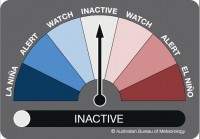La Nina comes to an end in Australia
30/03/2021

The Bureau of Meteorology has announced the end of the 2020-21 La Niña.
The La Niña was declared on 29 September 2020, with spring and summer seeing above-average rainfall in most of northern and eastern Australia.
This is typical of La Niña systems, which generally bring wetter spring and summer conditions for eastern Australia.
The increase in rain reduced the fire risk over the last summer and also contributed to an increased chance of tropical cyclones and an increased risk of flooding as seen in the recent flood events through Queensland and New South Wales.
In recent weeks, the Bureau's climatologists have noted a steady decline in La Niña indicators in the Pacific Ocean, with the La Niña/El Niño outlook now re-set to INACTIVE. Climate modelling shows few signs of a second La Niña or El Niño development for the foreseeable future.
Senior Climatologist Dr Naomi Benger said it's important to remember that even though the La Niña is over, there's always still the possibility of significant rainfall.
"We're forecasting above-average rainfall to continue into April for northern parts of Australia," she said.
Dr Benger said that, as La Niña recedes, secondary drivers of weather, such as the Madden–Julian Oscillation, will begin to play a larger role in influencing rainfall.
"The Madden-Julian Oscillation (MJO) moving through the tropics is expected to increase cloudiness and rainfall in far northern Australia over the next week or two. This also brings an increased risk of tropical low or tropical cyclone activity."
This atmospheric factor will be a likely driver in above-average rainfall and potential tropical activity in the first few weeks of April across far-northern Australia, even as early as the Easter long weekend.
Dr Benger encouraged people to remain vigilant when extreme weather is forecast, including monitoring the Bureau's warnings for information relevant to them.
People who are interested in more information about this can check our seasonal forecast here: www.bom.gov.au/climate/outlooks/#/overview/summary.
For general information about current weather conditions, forecasts and warnings, please check www.bom.gov.au or use the BOM Weather app.
A Video News Release featuring climatologist Dr Naomi Benger can be downloaded here.










